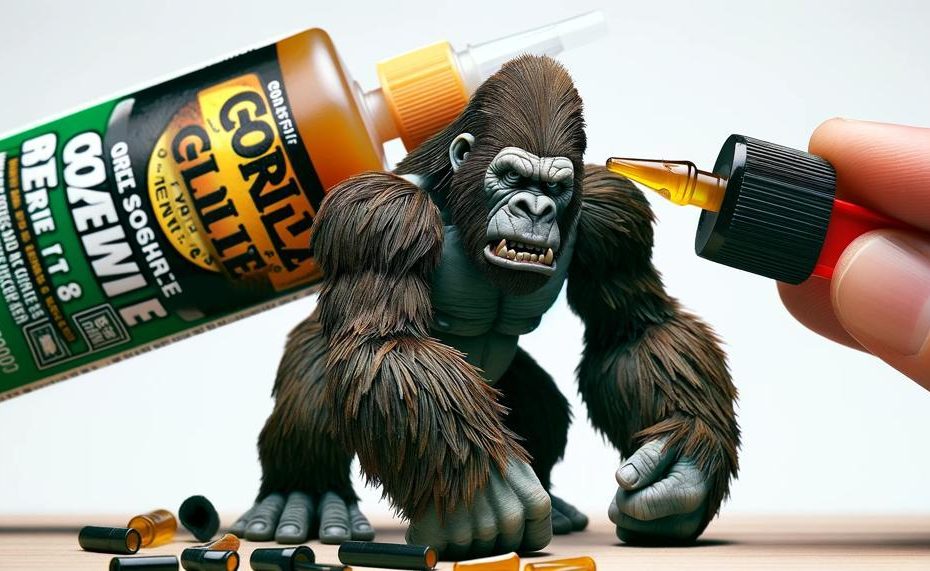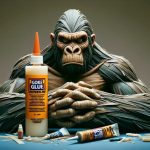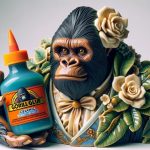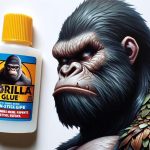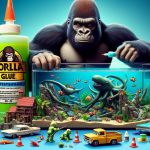Imagine a world where one stalwart glue could solve nearly all your sticky situations. That’s the promise of Gorilla Glue, a product that has garnered a reputation for its formidable bonding power.
But as with all things that seem too good to be true, it’s crucial to navigate the hype with a practical understanding of what Gorilla Glue can and cannot do.
So, can gorilla glue be used on anything?
Gorilla Glue is suitable for indoor or outdoor use and can bond to many surfaces, including: Stone, Metal, Glass, Brick, Ceramic, Wood, Foam, Concrete.
Gorilla Glue is waterproof and won’t break down when exposed to moisture. For best results, surfaces should be clean, dust free, and tight fitting. For shiny surfaces, like metals, glass, and some plastics, roughen up the material so the glue has something to bite into. You can also lightly dampen one surface with water using a damp cloth or spraying with water.
Gorilla Super Glue is a clear, high-strength adhesive that can bond to a variety of materials, including:Plastic, Metal, Stone, Wood, Ceramic, Rubber, Leather, Paper.
Gorilla Super Glue is formulated to achieve excellent results on difficult to bond substrates. It’s reinforced for impact resistance and dries in 10-45 seconds. However, it’s not recommended for use on polyethylene or polypropylene plastic.
So, let’s stick together as we unravel the mystery of this do-it-all adhesive.
Table of Contents
- 1 What is Gorilla Glue?
- 2 What Materials Can Gorilla Glue Bond?
- 3 What Surfaces Should be Avoided when Using Gorilla Glue?
- 4 How to Use Gorilla Glue Properly?
- 5 Does Gorilla Glue Need Moisture to Activate and Cure?
- 6 Is Excess Amount of Gorilla Glue Harmful?
- 7 What are the Advantages of Using Gorilla Glue?
- 8 Is Gorilla Glue Suitable for Outdoor Applications or Areas Exposed to Moisture?
- 9 Conclusion
What is Gorilla Glue?
Gorilla Glue is a renowned adhesive, celebrated for its formidable grip and versatility. It’s tailored to cater to a broad spectrum of bonding requirements and is a go-to solution for both DIY enthusiasts and professionals alike.
With its robust composition, Gorilla Glue offers a reliable fix for a multitude of materials, including plastic, metal, glass, wood, and ceramic.
What sets Gorilla Glue apart from its counterparts?
Gorilla Glue distinguishes itself through a unique set of attributes that bolster its performance across various applications:
| Feature | Gorilla Glue | Other Glues |
| Gap Filling | Expands to fill voids, perfect for uneven surfaces | Typically require flat, closely mated surfaces |
| Weather Resistance | Withstands heat and moisture, suitable for outdoors | Often compromised by extreme conditions |
| Drying Time | Quick setting, strong hold with hot glue sticks | Varies; some require longer to cure |
| Activation | Moisture-activated for a robust bond | Many don’t use moisture as a bonding agent |
Gorilla Glue’s expansion capability is a boon for those dealing with cracked or hole-ridden surfaces, allowing for a bond that goes beyond surface-level adhesion. Its resilience against the elements positions it as an ideal choice for projects that brave the outdoors.
The hot glue sticks are a testament to Gorilla Glue’s commitment to strength and efficiency, setting rapidly without sacrificing holding power. Moreover, the moisture-activation aspect of some Gorilla Glue products ensures a reinforced bond that stands the test of time.
These distinct qualities mean Gorilla Glue is not just another adhesive; it’s a solution crafted for durability and reliability, tackling the toughest of bonding challenges.
What Materials Can Gorilla Glue Bond?
Gorilla Glue is a stalwart in the adhesive market, renowned for its robust bonding capabilities across a diverse array of materials.
It’s a polyurethane-based adhesive with a penchant for forming tenacious bonds that last. Here’s a rundown of the materials this powerhouse can stick together:
| Material | Suitability | Notes |
| Wood | Excellent | Optimal strength, perfect for woodworking. |
| Metal | Good | Forms a strong bond; surface preparation is key. |
| Glass | Good | Clear formulas available; handle with care to prevent foaming. |
| Ceramics | Good | Clear glues recommended for a residue-free bond. |
| Stone | Good | Great for stone projects, avoid foaming for a clean finish. |
| Plastic | Varies | Not suitable for PP/PE plastics; check compatibility. |
| Leather | Temporary | For a more durable hold, consider specific leather adhesives. |
| Fabric | Use Specialised Glue | Gorilla Fabric Glue is the go-to for textiles. |
Do bear in mind, Gorilla Glue’s expansion during curing can be a boon or a bane; it allows filling gaps but requires restraint for precision jobs. For those pesky household repairs or creative endeavours, this glue is a trusty sidekick. Just remember, it’s not one-size-fits-all – particularly with plastic and leather, where it’s more of a makeshift fix.
What Surfaces Should be Avoided when Using Gorilla Glue?
Sensitive to Moisture
Gorilla Glue thrives with a bit of moisture but can wreak havoc on materials that don’t take kindly to water. Keep it away from:
- Leather
- Suede
- Fabrics
Extreme Temperatures
This adhesive isn’t a fan of the hot and heavy or the UV rays of the sun. Avoid slapping it on:
- Surfaces near stoves or high heat
- Items that bask in direct sunlight
Smooth Operators
Gorilla Glue grips best when it can sink its teeth into texture. For glossy mates, it’s a no-go unless you scuff them up first:
- Smooth surfaces
- Glossy finishes
Plastic Not-so-Fantastic
Some plastics and Gorilla Glue get along like oil and water. Give it a wide berth with:
- Polypropylene
- Polyethylene
To sum up, give Gorilla Glue the right conditions and it’ll stick with you through thick and thin, but pair it with the wrong surface and you’re heading for a sticky situation.
| Material Type | Should You Use Gorilla Glue? | Reason to Avoid |
| Leather/Suede/Fabrics | No | Moisture sensitivity can cause damage and discoloration |
| Surfaces near high heat | No | Glue can break down and lose bonding strength |
| Direct sunlight exposure | No | UV rays can weaken the adhesive bond |
| Glossy/Smooth surfaces | Only if roughened | Requires texture for strong adhesion |
| Some plastics (PP/PE) | No | Chemical reaction can cause melting or deformation |
How to Use Gorilla Glue Properly?
To achieve optimal results with Gorilla Glue on various materials, follow these meticulous steps:
Selecting the Right Gorilla Glue
Identify the correct formula for the job. Options include original, gel, or specialized types for materials like wood or fabric.
Surface Preparation
Ensure surfaces are clean, dry, and free from dust or oil. This step is crucial for a steadfast bond.
Glue Application
| Material | Application Method | Set Time |
| Wood | Apply a modest amount to one side. Original formula is best. | Clamp for 1-2 hours |
| Plastic* | Use a precision tip for a small quantity. Gel is apt for vertical surfaces. | Hold 10-45 seconds |
| Metal/Glass | A thin layer with a brush for even distribution. Clear formula for glass. | Clamp metal for 1-2 hours |
| Ceramic | Dab a small amount with precision tip. Super Glue is ideal. | Press for 10-45 seconds |
| Fabric | Apply Fabric Glue evenly. Avoid original that foams. | Leave to dry |
| Leather | Temporary fix with original. For permanent, opt for Barge Cement. | Set time varies |
Not suitable for polyethylene or polypropylene.
Pressing Surfaces Together
Join materials firmly. Press or clamp as per the table above to ensure a solid grip.
Wipe Off Excess Glue
Act swiftly with a clean cloth to remove any surplus adhesive before it sets.
Cleanup
Post-use, tidy up your workspace and tools quickly to dodge any sticky situations.
Safety First
Don protective gear for your skin and eyes, and make sure the room is well-aired.
Gorilla Glue, famed for its strength and versatility, serves well for a wide array of materials. Its foaming property when setting on wood fortifies bonds, yet may cause metal to have slight imperfections. Always store your glue in a cool, dry place, ready for your next project.
For an enduring outdoor wood project, consider Gorilla Wood Glue. When mending glass without marks, Gorilla Clear Glue shines. Remember, Gorilla Glue is not a mate for PP or PE plastics.
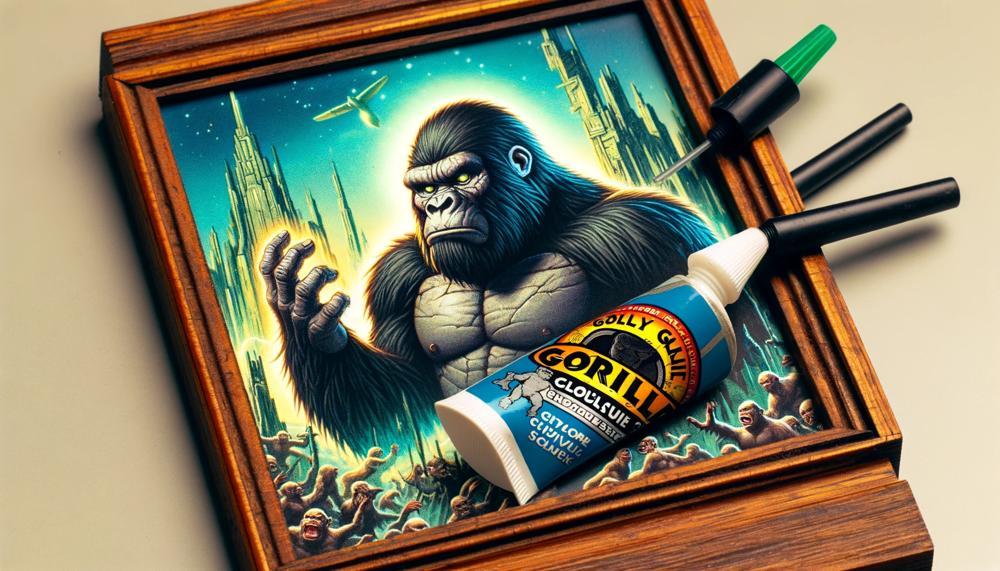
Does Gorilla Glue Need Moisture to Activate and Cure?
Yes, Gorilla Glue does require moisture to activate and properly cure. Here’s how moisture is critical to the process:
Activation:
When you apply Gorilla Glue, the presence of moisture begins the chemical reaction needed for the glue to set. It’s not about soaking the material; a slight dampness is sufficient.
This moisture kick-starts the polyurethane formula, causing it to expand and foam as it penetrates the surfaces being bonded, ensuring a strong adhesive layer.
Curing:
During the curing phase, Gorilla Glue continues to use the moisture in the air and from the material surfaces to solidify into its final, toughened state.
Adequate moisture ensures the glue expands correctly and cures without issue. In drier conditions, a light mist of water can aid the process.
Preparation and Drying Time:
Surface preparation is key. Before application, ensure surfaces are clean and give a quick wipe with a damp cloth if they are bone dry.
After applying the glue, clamp the surfaces together for at least 1-2 hours. Full curing can take 24 hours or more, depending on the environment.
Is Excess Amount of Gorilla Glue Harmful?
Excessive use of Gorilla Glue isn’t just a sticky situation; it can be downright dicey. Here’s what happens when you go overboard with this mighty adhesive:
| Aspect | Excessive Glue Impact | Recommended Practice |
| Safety | Increased chemical exposure, risk of irritation and breathing issues. | Use sparingly to minimize health risks. |
| Effectiveness | Weak bonds, unreliable results. | Apply just enough to create a strong bond. |
| Material Integrity | Potential damage from glue expansion. | Apply with care to protect materials. |
| Cleanliness | Messy overflow, tough clean-up. | Be precise to keep the workspace tidy. |
| Economy | Wasted product and money. | Conserve glue to save resources. |
In a nutshell, stick to the straight and narrow with Gorilla Glue – a little goes a long way.
What are the Advantages of Using Gorilla Glue?
Gorilla Glue boasts a unique set of benefits, setting it apart from the crowd. Its tenacity is legendary, creating a bond that’s tough to beat. Here’s a no-frills breakdown:
| Characteristic | Gorilla Glue | Other Glues |
| Composition | Polyurethane-based, which expands into materials for a formidable grip. | Various, often without the expanding properties that provide extra strength. |
| Bonding Strength | Exceptional strength due to its expanding nature, gripping materials with a robust hold. | Strength varies, often less robust and prone to weakening over time. |
| Durability | Water-resistant and can withstand temperature changes, making it a lasting solution. | Many are susceptible to water and temperature, leading to bond deterioration. |
| Versatility | Adheres to a wide range of materials including wood, metal, and plastic. | Often limited to specific material types, lacking the versatility of Gorilla Glue. |
| Usage | A little goes a long way; overuse can create issues, so it’s cost-effective. | May require more product to achieve a similar hold, potentially increasing costs. |
Gorilla Glue’s prowess isn’t just talk; it walks the walk, with a bond that’s tough as nails. It’s the go-to for jobs that demand a glue that can take a beating and come out on top.
Whether it’s holding together your favourite vase or a DIY project that needs to last through the seasons, Gorilla Glue’s got your back.
Is Gorilla Glue Suitable for Outdoor Applications or Areas Exposed to Moisture?
Yes, Gorilla Glue is suitable for outdoor applications and areas exposed to moisture. The manufacturer asserts its product is 100% waterproof, meaning it’s engineered to endure the elements. Its polyurethane formula allows for a steadfast bond that won’t buckle under the presence of water or humidity.
Properties of Gorilla Glue:
- Waterproof: It won’t break down when wet.
- Versatile: Suitable for wood, metal, stone, ceramics, and more.
- Expansive Nature: Fills in gaps between surfaces, creating a stronger bond.
Table of Outdoor Suitability:
| Feature | Benefit | Outdoor Suitability |
| Waterproof | Resists water, preventing bond failure | High suitability |
| Versatile Material Bonding | Useful for various outdoor materials | High suitability |
| Expanding | Fills gaps for a stronger hold | High suitability |
Conclusion
To sum up, Gorilla Glue proves to be a strong and adaptable adhesive choice that can handle a wide range of bonding difficulties. Our thorough guide has shed light on the chemistry that supports its strong binding, the materials it works best with, and the situations in which it isn’t the greatest choice. It works well on stone, wood, and ceramic surfaces, but be careful when using it on leather, plastic, and smooth or delicate surfaces.
Choosing the appropriate Gorilla Glue type for your material, carefully prepping surfaces, and sparingly applying the glue are all necessary for optimal use. Achieving that robust, long-lasting connection depends critically on the subtleties of its application, such as the expansion during curing and moisture activation. Furthermore, being aware of its limitations—such as its intolerance for particular polymers and very high temperatures—helps avoid overuse and disappointment.
When applied properly, Gorilla Glue provides a strong option for both professionals and do-it-yourself enthusiasts doing home repairs. Always put safety first, abide by the application’s instructions, and store it properly for later usage. Now that you know this, Gorilla Glue may be a go-to glue for a lot of people, but it’s not exactly “anything.”

